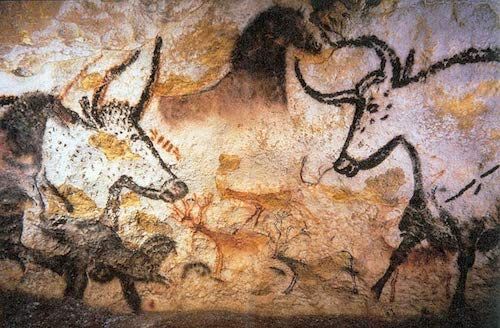Aurochs
 The aurochs was the ancestor of all current domesticated cattle, including the humped zebu cattle of South Asia and East Africa. None are now living (except in strictly cladistic terms), but they have not been extinct for long; the last one, a female, was killed in what is now Poland in 1627. In addition to skeletal re mains, there is plenty of human testimony about them, beginning with the paintings on Pleistocene cave walls. They were hunted by the Romans, who made hunting horns out of their horns, and they figured in the bestiaries compiled by naturalists who might actually have seen them. Their original distribution was broad, stretching across Eurasia and North Africa. Hunting doubtless contributed to their decline, but the primary and secondary effects of domestication were also important. The spread of agriculture transformed the aurochs' habitat, and once the process of domestication was underway, domesticators normally tried to eliminate the wild relatives of their animals, who might be perceived as potential competitors, threats, and general nuisances.
The aurochs was the ancestor of all current domesticated cattle, including the humped zebu cattle of South Asia and East Africa. None are now living (except in strictly cladistic terms), but they have not been extinct for long; the last one, a female, was killed in what is now Poland in 1627. In addition to skeletal re mains, there is plenty of human testimony about them, beginning with the paintings on Pleistocene cave walls. They were hunted by the Romans, who made hunting horns out of their horns, and they figured in the bestiaries compiled by naturalists who might actually have seen them. Their original distribution was broad, stretching across Eurasia and North Africa. Hunting doubtless contributed to their decline, but the primary and secondary effects of domestication were also important. The spread of agriculture transformed the aurochs' habitat, and once the process of domestication was underway, domesticators normally tried to eliminate the wild relatives of their animals, who might be perceived as potential competitors, threats, and general nuisances.

The aurochs has recently had a kind of revival among people attached to a nostalgic idea of old Europe (pure, strong, maybe barbaric). In the 1920s and 1930s, Heinz and Lutz Heck, brothers and zoo directors, attempted to recreate the aurochs by “breeding back” from various European breeds that had retained characteristics that they identified as primitive. The symbolism surrounding this allegedly primordial European animal was readily incorporated into Nazi ideology, and their efforts were appreciated by senior Nazi officials. Others have been more critical, not only on political grounds, but also because both brothers concentrated on superficial characteristics such as color and horn shape, and since neither kept careful records of his original stock or the pedigrees of his “aurochs.”
 Although the reputation of the Heck brothers was greatly diminished after World War II, their cattle have continued to enjoy a kind of niche esteem. Herds are scattered across Europe, mostly in barns and paddocks like ordinary cattle, but in some places, like Oostvaardersplassen, a nature reserve in the Netherlands, they have been introduced as part of an attempt to recreate the pre-agricultural landscape. And an attempt is underway to repeat the Hecks' attempt, but to do it better. According to the Taurus Foundation, which is based in the Netherlands, “The aurochs has always been at the very root of the whole idea of a continent called Europe. It is in fact our continent’s defining animal. (1) Using relatively recent (but not absolutely the most recent) technologies, they have developed a breed called the TaurOs which is currently being introduced in rewilding locations in Portugal, Italy, Romania, and Croatia.
Although the reputation of the Heck brothers was greatly diminished after World War II, their cattle have continued to enjoy a kind of niche esteem. Herds are scattered across Europe, mostly in barns and paddocks like ordinary cattle, but in some places, like Oostvaardersplassen, a nature reserve in the Netherlands, they have been introduced as part of an attempt to recreate the pre-agricultural landscape. And an attempt is underway to repeat the Hecks' attempt, but to do it better. According to the Taurus Foundation, which is based in the Netherlands, “The aurochs has always been at the very root of the whole idea of a continent called Europe. It is in fact our continent’s defining animal. (1) Using relatively recent (but not absolutely the most recent) technologies, they have developed a breed called the TaurOs which is currently being introduced in rewilding locations in Portugal, Italy, Romania, and Croatia.
1. Frans Schepers andd Ronald Goderie, “Foreword,” in Ronald Goderie, Wouter Helmer, Henri Kerkdijk-Otten and Staffan Widstrand, The Aurochs: Born to be Wild: The Comeback of a European Icon (Zutphen, Netherlands: Roodbont, 2013).
| « Woolly Mammoth | British Red Squirrel » |
